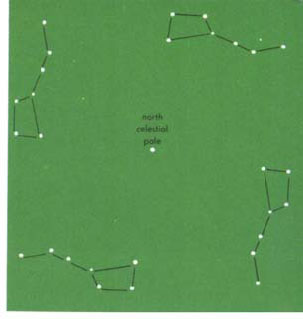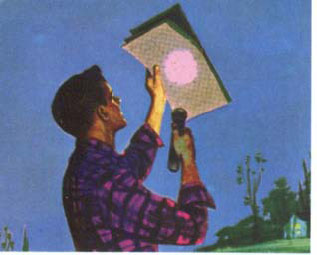First Steps in Observing
Local conditions always put a limit on what an observer can see. Faint stars become lost in the glow of city lights. Heavy traffic on a nearby street may cause a star image in one’s telescope to shiver. If the telescope is pointed at a planet that appears just over a neighbor’s roof, heated air rising from the roof may turn the planet’s image into a “boiling” blob. Gusts of wind, clouds suddenly rolling in, and inconveniently located trees are other hazards.
The observer with a broad, open horizon, free from interfering lights, is lucky. City observers sometimes must retreat to a park to see more than the Moon or a few bright stars. The suburbanite must place his telescope so that a building or hedge will block the light from a neighbor’s living room or front porch.
Unnecessary discomforts can quickly spoil the fun of observing. In winter, warm clothing is vital. In summer, a mosquito repellent may be necessary. In any season, a stool or chair will spell comfort during long periods at the telescope. For observers using binoculars, a reclining chair makes it easier to observe objects high overhead.
Oddly enough, the clearest night is not always the best for observing. The atmosphere may be quite turbulent. Differences in density between warm and cold air currents cause light to be refracted, or bent, irregularly as it comes down through the atmosphere. The images seen in the telescope then “boil.” A slightly hazy sky, with relatively still air, is preferred.
The nearer a celestial object is to the horizon, the less clearly it will be seen, usually. Its light comes slanting through Earth’s atmosphere and thus passes through more disturbing air currents and dust than does light from an object higher in the heavens. Moonlight, too, interferes, and by the time the Moon is full, only the bright stars can be seen.
To detect faint objects, experienced observers often use “averted” vision. They look a little to one side of the object, so that its light will fall on a more sensitive part of the retina.
Suppose the observer wants to find the great red star Betelgeuse. He looks it up in the index of this book, which refers him to the chart here. There he sees that Betelgeuse is at the northeast corner of a group of bright stars forming the constellation Orion. The chart shows Orion in relation to the other constellations, and the time of year when it is conveniently visible. With this information, the observer finds Orion in the sky (if the time of year and time of night are right), and Betelgeuse is identified.
Betelgeuse is easy to spot because it is red and prominent. Most sky objects are fainter and tend to become lost in the multitude of stars visible in binoculars and telescopes. To find a faint object, we must first identify bright stars near it and then use these as guides. Their positions are easier to hold in mind if we notice the patterns they form—squares, triangles, circles, loops.
Suppose we want to get a look at the famous star cluster M13 in the constellation Hercules. The chart (here) shows it is located on an almost straight line between two stars forming the west side of a “keystone” at the center of the constellation. We find the constellation and the keystone. With reference to the North Star, we decide which is the west side of the keystone. Then, with the help of binoculars (because the object is very faint), the cluster M13 is spotted.
Binoculars, too, make a good yardstick. In binoculars with a 7° field, for instance, the diameter of the circle of sky shown is always 7°. We can measure long distances across the sky by 7° steps. In telescopes, size of field (see here) varies according to the power of the eyepiece being used. The field may be something like ½° with the ¾-inch eyepiece, or 1° with the 1¼-inch.
To determine the field obtained with each eyepiece, point the telescope toward any prominent, concentrated group of stars near the equator. Look through the eyepiece and note the stars at opposite sides of the field; then check your atlas to determine the distance in degrees between these stars. This distance is the field given by the eyepiece.
The eyepiece field can be determined also by noting how long it takes a star near the equator to cross the field. The motion is ¼° per minute.
Suppose you have found Betelgeuse in Orion and want to find μ Orionis, a fainter star in the same constellation. A star atlas shows that μ Orionis is about 2° north and 1° east of Betelgeuse. Looking at Betelgeuse again, you mentally draw from it a line to the North Star. This line is in the direction of north. At right angles to north, and in the direction from which the stars are moving, is east. With your mental yardstick or with binoculars, you measure 2° north and 1° east from Betelgeuse, and there is μ Orionis.
Directions are most easily confused near the celestial pole. Remember: the motion of stars in the northern hemisphere as they revolve around the pole is counterclockwise. As you face north, the stars over the celestial pole are moving westward (toward your left) and the stars below the pole are moving eastward (toward your right). In the southern hemisphere, stars revolve clockwise around the pole.
When using a chart, hold it up toward the sky in the direction in which you are looking. Rotate it until the star pattern on the map matches the pattern as you see it in the sky.






